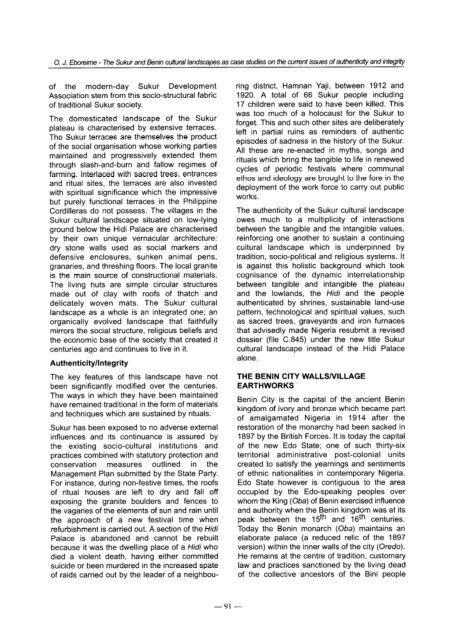Mul - unesdoc - Unesco
Mul - unesdoc - Unesco
Mul - unesdoc - Unesco
Create successful ePaper yourself
Turn your PDF publications into a flip-book with our unique Google optimized e-Paper software.
0. J. Eboreime - The Sukur and Benin cultural landscapes as case studies on the curent issues of authenticity and integrity<br />
of the modern-day Sukur Development<br />
Association stem from this socio-structural fabric<br />
of traditional Sukur society.<br />
The domesticated landscape of the Sukur<br />
plateau is characterised by extensive terraces.<br />
The Sukur terraces are themselves the product<br />
of the social organisation whose working parties<br />
maintained and progressively extended them<br />
through slash-and-burn and fallow regimes of<br />
farming. Interlaced with sacred trees, entrantes<br />
and ritual sites, the terraces are also invested<br />
with spiritual significance which the impressive<br />
but purely functional terraces in the Philippine<br />
Cordilleras do not possess. The villages in the<br />
Sukur cultural landscape situated on low-lying<br />
ground below the Hidi Palace are characterised<br />
by their own unique vernacular architecture:<br />
dry stone walls used as social markers and<br />
defensive enclosures, sunken animal pens,<br />
granaries, and threshing floors. The local granite<br />
is the main source of constructional materials.<br />
The living huts are simple circular structures<br />
made out of clay with roofs of thatch and<br />
delicately woven mats. The Sukur cultural<br />
landscape as a whole is an integrated one; an<br />
organically evolved landscape that faithfully<br />
mirrors the social structure, religious beliefs and<br />
the economic base of the society that created it<br />
centuries ago and continues to live in it.<br />
Authenticityllntegrity<br />
The key features of this landscape have not<br />
been significantly modified over the centuries.<br />
The ways in which they have been maintained<br />
have remained traditional in the form of materials<br />
and techniques which are sustained by rituals.<br />
Sukur has been exposed to no adverse external<br />
influences and its continuance is assured by<br />
the existing socio-cultural institutions and<br />
practices combined with statutory protection and<br />
conservation measures outlined in the<br />
Management Plan submitted by the State Party.<br />
For instance, during non-festive times, the roofs<br />
of ritual houses are left to dry and fall off<br />
exposing the granite boulders and fentes to<br />
the vagaries of the elements of sun and rain until<br />
the approach of a new festival time when<br />
refurbishment is carried out. A section of the Hidi<br />
Palace is abandoned and cannot be rebuilt<br />
because it was the dwelling place of a Hidi who<br />
died a violent death, having either committed<br />
suicide or been murdered in the increased spate<br />
of raids carried out by the leader of a neighbou-<br />
-9l-<br />
ring district, Hamnan Yaji, between 1912 and<br />
1920. A total of 66 Sukur people including<br />
17 children were said to have been killed. This<br />
was too much of a holocaust for the Sukur to<br />
forget. This and such other sites are deliberately<br />
left in partial ruins as reminders of authentic<br />
episodes of sadness in the history of the Sukur.<br />
All these are re-enacted in myths, songs and<br />
rituals which bring the tangible to life in renewed<br />
cycles of periodic festivals where communal<br />
ethos and ideology are brought to the fore in the<br />
deployment of the work force to carry out public<br />
works.<br />
The authenticity of the Sukur cultural landscape<br />
owes much to a multiplicity of interactions<br />
between the tangible and the intangible values,<br />
reinforcing one another to sustain a continuing<br />
cultural landscape which is underpinned by<br />
tradition, socio-political and religious systems. It<br />
is against this holistic background which took<br />
cognisance of the dynamic interrelationship<br />
between tangible and intangible the plateau<br />
and the lowlands, the Hidi and the people<br />
authenticated by shrines, sustainable land-use<br />
pattern, technological and spiritual values, such<br />
as sacred trees, graveyards and iron furnaces<br />
that advisedly made Nigeria resubmit a revised<br />
dossier (file C.845) under the new title Sukur<br />
cultural landscape instead of the Hidi Palace<br />
alone.<br />
THE BENIN CITY WALLSNILLAGE<br />
EARTHWORKS<br />
Benin City is the capital of the ancient Benin<br />
kingdom of ivory and bronze which became part<br />
of amalgamated Nigeria in 1914 after the<br />
restoration of the monarchy had been sacked in<br />
1897 by the British Forces. It is today the capital<br />
of the new Edo State; one of such thirty-six<br />
territorial administrative post-colonial units<br />
created to satisfy the yearnings and sentiments<br />
of ethnie nationalities in contemporary Nigeria.<br />
Edo State however is contiguous to the area<br />
occupied by the Edo-speaking peoples over<br />
whom the King (Oba) of Benin exercised influence<br />
and authority when the Benin kingdom was at its<br />
peak between the 1 5th and 16th centuries.<br />
Today the Benin monarch (Oba) maintains an<br />
elaborate palace (a reduced relit of the 1897<br />
version) within the inner walls of the city (Oredo).<br />
He remains at the centre of tradition, customary<br />
law and practices sanctioned by the living dead<br />
of the collective ancestors of the Bini people

















